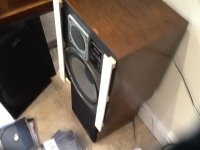I have hesitated about posting this because I assume it is not a new idea, and it is only justified by my subjective opinion of the effect.
I originally used this as a way of hiding exposed edges of self builds, and noticed an aural effect, that I could not ignore. I now would not have a speaker without these additions, so convinced am I of the benefit.
As the picture shows I have a strip of thin wood (or card) <3mm thick about 3-4 cm wide the length of the cabinet on both sides. It stands away from the baffle about 1-2 cm.
The effect it has is to bring a more focused sound, to the extent of increasing presence, and improves the high frequencies.
It takes 10 minutes to try it out fixing the strips with blutak.
My uneducated guess is that the strips interfere with the diffracted waves from the edges of the cabinet. I would be interested in any views.
I originally used this as a way of hiding exposed edges of self builds, and noticed an aural effect, that I could not ignore. I now would not have a speaker without these additions, so convinced am I of the benefit.
As the picture shows I have a strip of thin wood (or card) <3mm thick about 3-4 cm wide the length of the cabinet on both sides. It stands away from the baffle about 1-2 cm.
The effect it has is to bring a more focused sound, to the extent of increasing presence, and improves the high frequencies.
It takes 10 minutes to try it out fixing the strips with blutak.
My uneducated guess is that the strips interfere with the diffracted waves from the edges of the cabinet. I would be interested in any views.
You may be getting some diffusion of the wave propagation around the cabinet edge, which breaks up some of the shorter wavelength frequencies before they're refracted and then reflected from the boundary surface behind the speaker. Just by masking the cabinet edge, you're reducing the reflective components of edge diffraction itself.
One guess is as good as another maybe. It might be interesting to measure around the edge in either case. Maybe simpler would be to replace the edge deflectors with some damping material and hear whether it affects the same issues.
Study aircraft, race car aerodynamics. The baffle eigenmodes are whipping back n' forth, up n' down at the SoS across the driver, not to mention the room's impact on it, so for sure 'coloring' its higher frequencies as RCA's Harry Olson proved way back when: https://www.diyaudio.com/forums/att...-speaker-idea-am-mad-olsen-baffleshape-fr-gif
It'll change the edge diffraction most notable at tweeter frequencies. For better or for worse who knows.
Felt seems to give good results:
David Ralph's Speaker Pages - Felt Effects on Baffle Diffraction
Felt seems to give good results:
David Ralph's Speaker Pages - Felt Effects on Baffle Diffraction
To my eyes, felt never looks very good. My strips if done properly look fine. (The photo is just a lash up as I am messing around with some old budget speakers)
Measurements are revealing, but I am more interested in the effect on the sound; good, bad, or non-discernible. I should have mentioned that they make a marked improvement on the stereo separation as well.
If reducing the effect of diffraction can be so beneficial, I am surprised so few speakers address the issue.
Measurements are revealing, but I am more interested in the effect on the sound; good, bad, or non-discernible. I should have mentioned that they make a marked improvement on the stereo separation as well.
If reducing the effect of diffraction can be so beneficial, I am surprised so few speakers address the issue.
It probably the cost involved. It's simpler to make a square edged box than incorporating rounded edges and such. Besides that, room placement will introduce additional diffractions from various items near the loudspeaker. If you aren't able to clear the area around the speakers and move them out into the room away from walls you're gonna have those reflections to deal with, too. My guess is that the manufacturers realize this and don't worry too much about their enclosures contribution.
- Home
- Loudspeakers
- Multi-Way
- Has this been done before?
